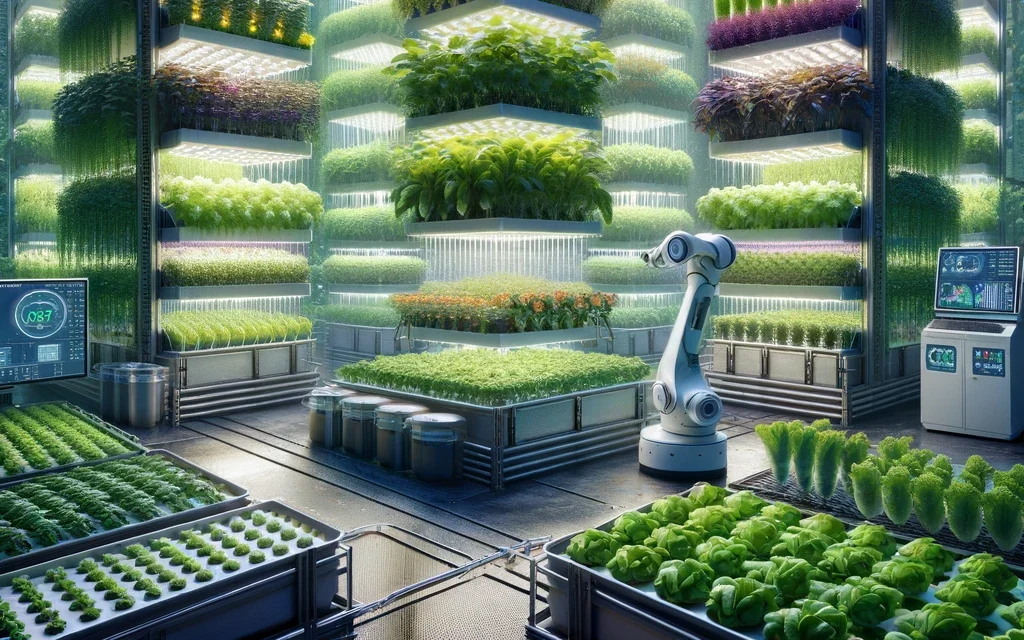Aquaponics is an innovative and sustainable method of food production that combines aquaculture (the breeding of fish and other aquatic organisms) with hydroponics (the cultivation of plants in water) in a symbiotic system. This approach is gaining importance, especially in the context of vertical farming, or vertical agriculture. The following describes in detail the functioning of aquaponics, highlights its advantages, and compares it with other cultivation systems.
Functioning of Aquaponics
Aquaponic systems are based on the symbiosis between fish and plants coexisting in a closed water cycle. The core of this system is the natural relationship between the fish’s excretions, nitrifying bacteria, and plants. The fish produce ammonia-rich wastes, which can be harmful to the fish themselves if present in high concentrations. This is where the nitrifying bacteria come into play, living in bioactive filters or directly in the plant root zones. These bacteria convert ammonia first into nitrite and t hen into nitrate, a form of nitrogen that plants can absorb and use for their growth.
In a vertical farming system, this process is spatially optimized by arranging multiple levels of plant areas above the fish tanks. This maximizes production capacity per square meter and allows for efficient use of urban or limited spaces. Water is moved vertically by pumps, enabling a continuous flow of nutrients to the plants and purified water back to the fish.
Delving into the Technical Aspects of Aquaponics
Aquaponics combines aquaculture (fish farming) with hydroponics (plant production without soil) in a closed water cycle. This process begins with the fish, which excrete nutrients in the form of ammonia. Specialized microorganisms, especially nitrifying bacteria, first convert ammonia into nitrites and then into nitrates. This conversion is crucial, as ammonia and nitrites are toxic to fish, while nitrates can be absorbed by plants as nutrients.
In vertical aquaponic systems, this principle is used to enable efficient, multi-tiered food production in urban or space-limited environments. Such systems require careful planning regarding water management, lighting conditions, and temperature control t o create optimal conditions for fish and plants.
Socio-Economic Aspects of Aquaponics
Aquaponics offers not only ecological but also socio-economic benefits. By enabling local and sustainable food production, urban areas can become more autonomous in terms of their food supply. This reduces dependency on long supply chains, which are vulnerable to disruptions, and promotes local economic cycles. Furthermore, the establishment and maintenance of aquaponic systems create jobs and offer educational opportunities, especially in the fields of science, technology, engineering, and mathematics (STEM).
Comparison with Traditional Agriculture and Hydroponics
Traditional Agriculture: Compared to traditional agriculture, which relies on extensive land requirements, significant water consumption, and the use of chemical fertilizers and pesticides, aquaponics offers significant advantages. Aquaponic systems reduce water demand by up to 90% through the circulation and reuse of water in the system. As it is a closed system, chemical fertilizers and pesticides become unnecessary, leading to healthier and more environmentally friendly production.
Hydroponics
Hydroponics, the cultivation of plants in nutrient-rich water solutions without soil, shares some advantages with aquaponics, such as water savings and the possibility of vertical arrangement. The main difference, however, lies in the source of nutrients . While hydroponic systems rely on artificially supplied nutrient solutions, aquaponics naturally generates nutrients through the utilization of fish waste. This makes aquaponics a more sustainable system, as it reduces dependence on externally supplied re sources and potentially lessens environmental impacts from the production and transport of fertilizers.
Advantages over Aquaculture
Aquaculture
Aquaculture alone often faces the challenge of dealing with fish waste products, which, if not properly managed, can lead to water quality issues. Aquaponics solves this problem by using the wastes as a resource for plant growth, thus eliminating the need for expensive and environmentally harmful wastewater treatment systems.
Challenges and Solutions
Despite the numerous advantages of aquaponics, there are challenges, including initial investments and the required expertise. To overcome these challenges, potential operators of aquaponic systems can partner with research institutions to gain access to expertise and financial support. Additionally, there are increasingly more educational offerings and resources online that provide necessary knowledge to interested individuals.
Another approach is the modularization and scaling of aquaponic systems. By starting with smaller, modular systems, individuals can gain experience and gradually expand the system. This can lower initial costs while providing valuable insights into the ope ration and maintenance of the system.
Global Context and Sustainability
The significance of aquaponics extends far beyond local applications. In a global context, this method offers a solution to some of the most pressing challenges in food production, including water scarcity, soil degradation, and the need to adapt food production to climate change. Aquaponic systems can be powered by renewable energy, improving their carbon footprint, and making them a key component in the transformation towards a more sustainable global food economy.
Outlook and Development Potential
The technology and methodology of aquaponics are constantly evolving. Advances in automation and artificial intelligence offer the potential to further increase the efficiency and productivity of aquaponic systems. For example, sensors and automated systems for monitoring and adjusting water quality, lighting conditions, and nutrient supply could be used to ensure optimal growth conditions.
Conclusion and Outlook
Aquaponics as part of vertical farming offers a forward-looking solution to many of the challenges facing global food production. Through the efficient use of resources, the reduction of environmental impacts, and the ability to be used in various environm ents, aquaponics has the potential to make a significant contribution to food security and sustainable development. The combination of technological innovation, socio-economic benefits, and the contribution to solving global challenges makes aquaponics an exciting field for research, development, and application.
Considering the rising global population and the increasing pressures on Earth’s natural resources, it is crucial to further develop and promote sustainable and efficient food production methods like aquaponics. By overcoming the current challenges and utilizing the full potential of this technology, we can pave the way to a more sustainable and secure food future.
Sources
“Aquaponic Gardening: A Step-By-Step Guide to Raising Vegetables and Fish Together” by Sylvia Bernstein
“The Aquaponic Farmer: A Complete Guide to Building and Operating a Commercial Aquaponic System” by Adrian Southern and Whelm King
“Vertical Farming: Feeding the World in the 21st Century” by Dickson Despommier
“Plant Factory: An Indoor Vertical Farming System for Efficient Quality Food Production” by Toyoki Kozai, Genhua Niu and Michiko Takagaki

